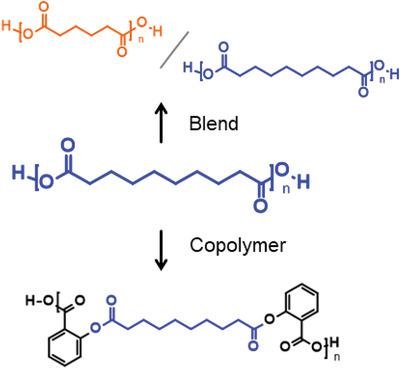当前位置:
X-MOL 学术
›
Macromol. Chem. Phys.
›
论文详情
Our official English website, www.x-mol.net, welcomes your
feedback! (Note: you will need to create a separate account there.)
Degradable Polymer Films Made from Poly(salicylic‐acid‐co‐sebacic acid) and Poly(sebacic anhydride)/Poly(adipic anhydride) Blends: Degradation Kinetics and Use as Sacrificial Layers for Polymer Multilayer Systems
Macromolecular Chemistry and Physics ( IF 2.5 ) Pub Date : 2020-05-19 , DOI: 10.1002/macp.202000106 Zhuoling Deng 1 , Esther K Riga 1 , Karen Lienkamp 1
Macromolecular Chemistry and Physics ( IF 2.5 ) Pub Date : 2020-05-19 , DOI: 10.1002/macp.202000106 Zhuoling Deng 1 , Esther K Riga 1 , Karen Lienkamp 1
Affiliation

|
Two approaches to obtain fast‐degrading polymer films based on poly(sebacic anhydride) (PSA) are presented, both of which target polymer films with a lower degree of crystallinity than pure PSA homopolymer: first, thin films are prepared from poly(adipic anhydride)/poly(sebacic anhydride) blends at different ratios, and second, films are made from the copolymer poly(salicylic acid‐co‐sebacic acid). These films are intended as sacrificial layers for self‐regenerating functional coatings, for example, to regenerate antimicrobial surface activity. The degradation kinetics of these films are analyzed by surface plasmon resonance spectroscopy. The results of the blends approach indicate that the blend degradation rate is accelerated only in the initial degradation phase (compared to PSA). The degradation kinetics study of the poly(salicylic‐acid‐co‐sebacic acid) film shows that this copolymer degrades faster than poly(sebacic anhydride) initially, releasing antimicrobial salicylic acid in the process. However, its degradation rate slows down at a mass loss >60% and approaches the PSA degradation curve at longer degradation times. When tested as sacrificial layer in self‐regenerating antimicrobial polymer stacks, it is found that the degradation rate is too low for successful layer shedding.
中文翻译:

由聚(水杨酸-共癸二酸)和聚(癸二酸酐)/聚(己二酸酐)共混物制成的可降解聚合物薄膜:降解动力学和用作聚合物多层系统的牺牲层
提出了两种获得基于聚(癸二酸酐)(PSA)的快速降解聚合物薄膜的方法,这两种方法都针对结晶度低于纯 PSA 均聚物的聚合物薄膜:首先,由聚(己二酸酐)制备薄膜)/聚(癸二酸酐)以不同比例混合,其次,薄膜由共聚物聚(水杨酸-co)制成-癸二酸)。这些薄膜旨在作为自我再生功能涂层的牺牲层,例如,再生抗菌表面活性。通过表面等离子共振光谱分析这些薄膜的降解动力学。共混方法的结果表明,共混物降解速率仅在初始降解阶段加速(与 PSA 相比)。聚(水杨酸)的降解动力学研究-癸二酸)薄膜表明,这种共聚物最初的降解速度比聚(癸二酸酐)快,在此过程中释放出抗菌水杨酸。然而,其降解速率在质量损失 >60% 时会减慢,并在较长的降解时间下接近 PSA 降解曲线。当在自再生抗菌聚合物堆叠中作为牺牲层进行测试时,发现降解率太低而无法成功脱落。
更新日期:2020-05-19
中文翻译:

由聚(水杨酸-共癸二酸)和聚(癸二酸酐)/聚(己二酸酐)共混物制成的可降解聚合物薄膜:降解动力学和用作聚合物多层系统的牺牲层
提出了两种获得基于聚(癸二酸酐)(PSA)的快速降解聚合物薄膜的方法,这两种方法都针对结晶度低于纯 PSA 均聚物的聚合物薄膜:首先,由聚(己二酸酐)制备薄膜)/聚(癸二酸酐)以不同比例混合,其次,薄膜由共聚物聚(水杨酸-co)制成-癸二酸)。这些薄膜旨在作为自我再生功能涂层的牺牲层,例如,再生抗菌表面活性。通过表面等离子共振光谱分析这些薄膜的降解动力学。共混方法的结果表明,共混物降解速率仅在初始降解阶段加速(与 PSA 相比)。聚(水杨酸)的降解动力学研究-癸二酸)薄膜表明,这种共聚物最初的降解速度比聚(癸二酸酐)快,在此过程中释放出抗菌水杨酸。然而,其降解速率在质量损失 >60% 时会减慢,并在较长的降解时间下接近 PSA 降解曲线。当在自再生抗菌聚合物堆叠中作为牺牲层进行测试时,发现降解率太低而无法成功脱落。











































 京公网安备 11010802027423号
京公网安备 11010802027423号